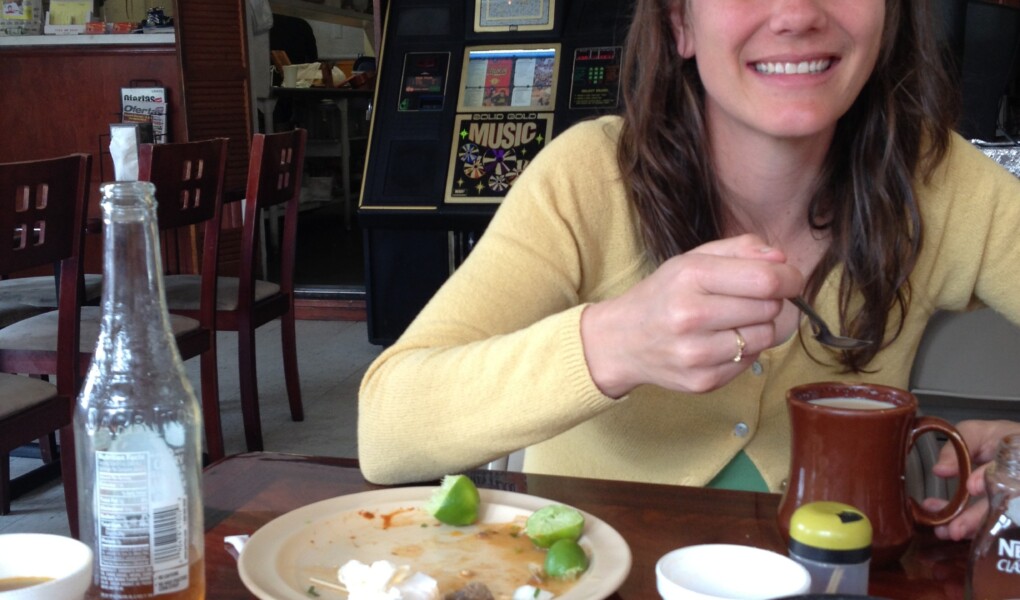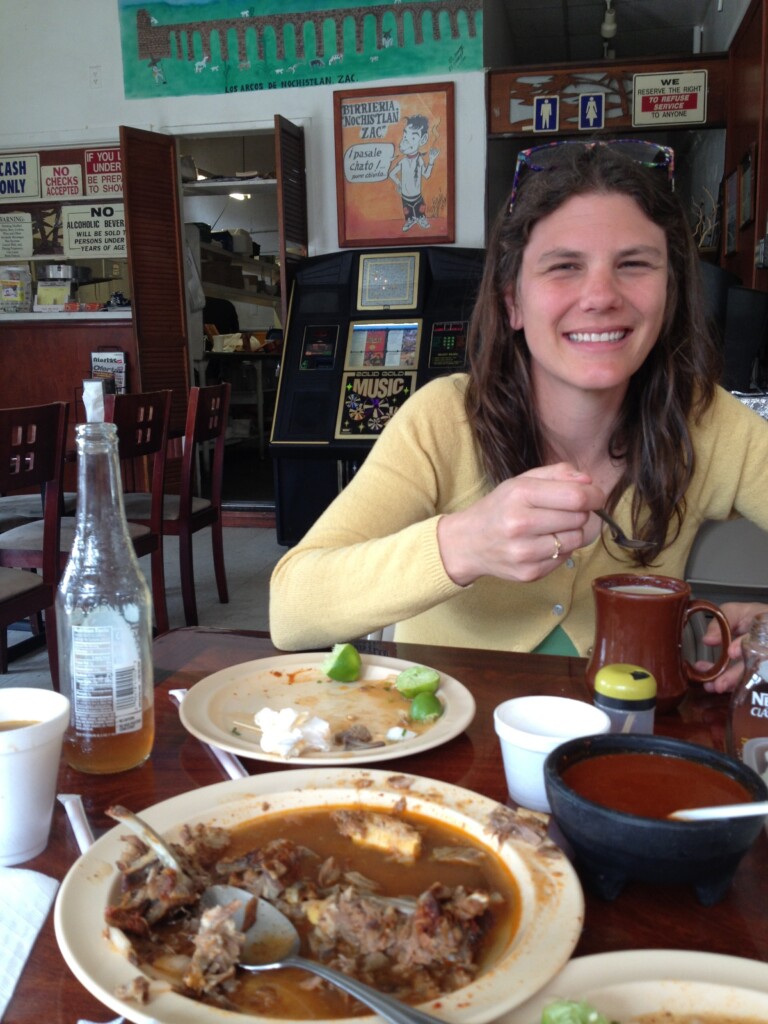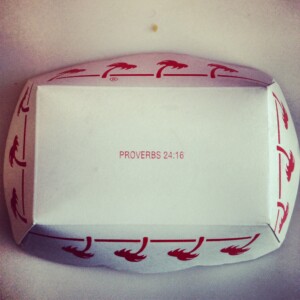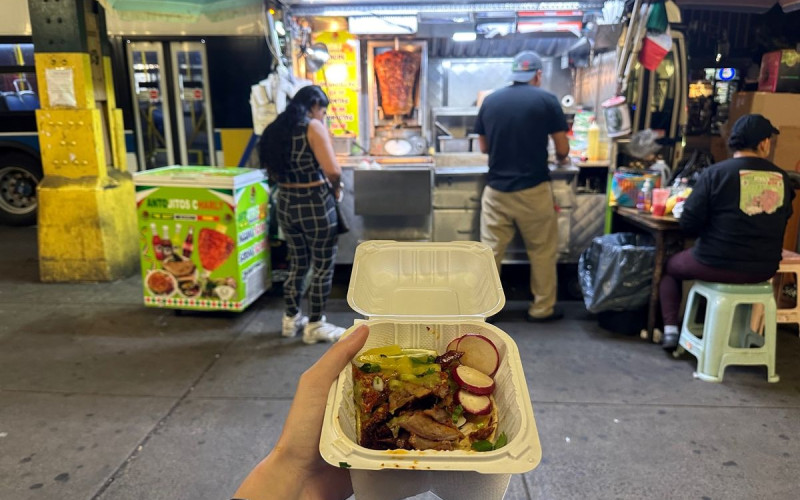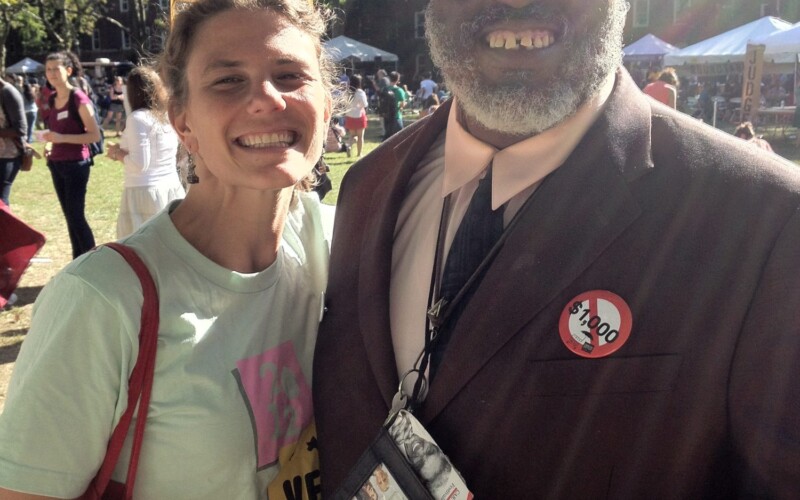Cindy and Andrew recently traveled to Los Angeles for a much-needed vacation. But of course, they could not resist exploring the waterfronts, markets, and street food of Southern California. Over the coming weeks, they will be sharing some of their experiences.
Confession: we travelled all the way to Los Angeles, and we did not eat from a single food truck. Now, given our chosen profession, that may seem an unforgivable sin, but during our seven days in Southern California, we did find our way to many street vendors, markets, and incredible immigrant-owned restaurants across the Los Angeles area. We are admitted neophytes to the sprawling Los Angeles food scene, but thanks to the advice of more seasoned friends, we had nary a regrettable meal on our trip.
Ricky’s Fish Tacos: One of our first food stops took us to Chinatown, but not for dim sum or dumplings. Recommended to us by our friend Helena at the Street Vendor Project, Ricky’s is a pop-up street vendor – no truck or cart, just a tent, some tables and fryers – renowned for his deep-fried fish and shrimp tacos. Owner Ricky Piña had been setting up in a lot in Los Feliz, but recent scrutiny has forced him from his regular location. On weekends he still operates in front of the LAX-C Asian food market. Piña does well for himself with his spartan operation – there are two menu items, plus delicious horchata or fresh coconut water to wash it down – but he has dreams of someday buying a truck and taking it on a nationwide tour. Food this good deserves to be served seven days a week.
Despite its great reputation for street food, Los Angeles actually does not allow any public street vending other than from food trucks, so pop-up vendors like Ricky are forced to vend from private land, and there are no sanctioned sidewalk food carts in the city. Despite the ban, street vendors abound, and the Autry National Center recently hosted a public program to highlight the stories of these vendors.
Find Ricky’s Fish Tacos by following him on Twitter.
[nggallery id=14]
Flor del Rio: Goat is delicious. We should all take it upon ourselves to eat more goat. That resolution would be a cinch if we lived in East LA, home of Flor del Rio Birrieria Nochistlan. They also serve only two things: goat tacos, and a goat platter, which comes with s side of tortillas and taco fixins (so really, one thing). And they just crush it. Incredibly succulent goat served on the bone that’s stewed to oblivion, paired with fresh, handmade tortillas. The dish is a specialty of Mexico’s Zacatecas state, and the restaurant bears the name of the owners’ hometown – the modest interior is replete with murals of the its 18th-century aqueduct. We didn’t catch the owner’s name, but he seems to handle the goat, while his mother makes the fresh tortillas, which came flying out of the kitchen piping hot whenever our tableside stack became a little shorter.
Read about Flor del Rio Birrieria Nochistlan in LA Weekly.
[nggallery id=15]
Busy Bee Market: For the first time in my life, I went to a restaurant based entirely on a recommendation from a rap song. The People Under the Stairs’ “The LA Song” features the lines:
I’m headed back to Pedro to sit up on the hill
Next to the Korean bell eating Busy Bee watching waves swell
High visibility, Catalina and sailboats.
We spent much of our trip in LA’s harbor complex (more on that later) in Long Beach and San Pedro, so I figured we should check out this “Busy Bee” – what we discovered was a modest market that specializes in enormous, heavily-sauced Italian sandwiches loaded with brined and basted meats. Sauce on a sandwich is a dangerous game – the more sauce you add, the more delicious the sandwich becomes (obviously), but you also risk passing a tipping point, after which the sandwich becomes less and less sandwich-like, and more of a soggy mess. Busy Bee shows no fear of passing this threshold, as they know their sandwiches are really just a vessel for delivering more sauce. Our barbecue chicken sandwich was a divine, sloppy mess, enjoyed from atop the hill in San Pedro with a view of the harbor.
[nggallery id=16]
Grand Central Market: This market was a revelation, and one that we stumbled upon completely by accident. Nestled in sterile and eerily vacant Downtown LA, the market is a bustling, dynamic public space unlike any market you can find in New York City. Our original destination was actually the Angel’s Flight, a one block-long funicular railway. Built in 1901 to connect the downtown department stores to the tony neighborhood of Bunker Hill, it is now more of a novelty than a true mass transit link, though it (supposedly) remains the shortest incorporated railway in the world. In 1969, when Bunker Hill was redeveloped into the high-rise district it is today, the Angel’s Flight was dismantled, and the tracks and cars were placed in storage until 1996, when it was rebuilt just down the block from its original location.
[nggallery id=17]
When the Grand Central Market opened on the ground floor of the Homer Laughlin Building in 1917, the tiny train gave it ready access to the wealthy clientele just up the hill. Today, the market offers a diverse assemblage of cuisine from LA’s immigrant communities, with vendors selling everything form pupusas to mole, kebabs to Chinese medicine. Unlike many of New York’s most popular markets, which tend to offer exclusively gourmet, artisanal, whatever-you-want-to-call-it fare that targets the particularly affluent customer, the Grand Central Market has a throwback feel with throwback prices. In recent months calls have been raised to redevelop the market – we just hope that whatever emerges will not only provide delicious, affordable food, but opportunities for immigrant vendors to find affordable spaces to sell it.
Visit the Grand Central Market.
In-N-Out Burger: Yes, I know, we are uncultured East Coasters who are still smitten with In-N-Out. But whatever. Their burgers, fries, and shakes are delicious, and their customer service is great. We actually drove straight from LAX to an In-N-Out when we arrived. I’ve been only a handful of times before, and I had never noticed something quirky about their paper products: they’re all inscribed with Bible verses. Our fries basket cited Proverbs 24:16 on the underside, while my milkshake cup had an almost unnoticeable “Proverbs 3:5” etched on the lower rim. Cindy wondered if perhaps the verses were potato- or beef-related, but they’re all pretty run-of-the-mill God is great/the righteous are awesome passages. This subtle campaign is apparently nothing more than an expression of the religious devotion of the Snyder family, which owns the chain, and they’ve been distributing the verses for more than 25 years with little fanfare or controversy. The company was recently lauded by Wafels & Dinges for remaining a family-owned company and “keeping its soul” – I guess it does that through good service, great food, and a little bit of the Bible.
Find an In-N-Out location (the closest one is only 1,500 miles from New York City).
Do(ugh)nuts, do(ugh)nuts everywhere, and not a Dunkin in sight: Who knew that LA was blanketed in independently-owned doughnut shops? While in New York City, it is an absurd struggle to find a decent, fresh-made donut – our most numerous chain “restaurant” is Dunkin Donuts and their factory-made, flavorless carboard discs – it seems that fresh, deep-fried pastries can be found every couple of blocks in a Southern California strip mall. Many of these establishments are owned by Asian immigrants, and they are often paired with Chinese restaurants, sometimes under the same roof. How that practice started remains a mystery, but according to Katie Robbins of The Atlantic, it may have been born of necessity – with high rents, it makes sense to work around the clock, serving doughnuts in the morning and lo mein at night. Someone should document these places, and their wonderfully creative signage, in a coffee table book or something, before the orange-and-purple menace puts them all out of business, as they did in the northeast.
Explore New York City’s food scene with Turnstile Tours! We offer weekly tours of food carts and trucks year-round, every Wednesday at 12pm in Manhattan’s Financial District, and every Friday at 2pm in Midtown. Or join our Immigrant Foodways Tour, which explores the food and culture of Latin American communities in Brooklyn’s East Williamsburg neighborhood, on select Saturdays at 10:30am. To join us, visit our tickets and information page or check our tour calendar.
This post was authored by Andrew Gustafson.

